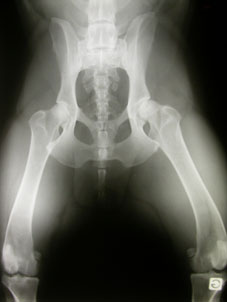54 - A case of an osteopathic dysfunction of the sacroiliac joint.
Uston is a 5 years old German shepherd, practising the ring.
His performances have decreased quite a lot in the last few months: he runs like a crab, and seems to lack in impulsion when he jumps the wall.
His owner brought him to his veterinary who noticed a pain on the extension of the right hindleg.
The anamnesis reports a coxofemoral joint dysplasia noted C/D.
The dog has a rest and is given non-steroidal anti-inflammatories for 2 weeks. Following this lap of time, the dog starts a short training but the same locomotion signs appear.
The osteopathic examination shows a classical dysfunctional chain:
left shoulder in supination dysfunction, D3 in left FRS, D13 and L3 in simple compensatory dysfunctions and a right iliac in upper dysfunction.
The most sensitive dysfunction is the right sacroiliac joint.
The owner then remembers a jumping injury which took place a year before. The right hindleg of the dog remained stuck on the top of the wall. The performances started decreasing after this incident.

The treatment is mostly done with structural technics and the dog is resting for three more weeks (he is only allowed walks on a leash ; no trainings and no competitions, etc.). No drugs are given except Arnica 5CH during 3 days.
The dog was checked 3 weeks later and his hindlegs showed more tonicity. There are no more proximal dysfunctions but the right sacroiliac joint returned to its abnormal position. It is corrected immediately.
After two more weeks of rest, Uston starts the training again; everything improves and the jumps come back to their normal original extention.
Here is the case of a dog who suffers from a bad bilateral coxofemoral joint dysplasia, but still works at good level and for who the ambulatory problem is not directely in relation with the handicap.
Surely this dog will not be a big champion because his joints do not allow him high level performances, but his story shows once again that one should not always condemn a dog to surgery or to ’hall carpet’ just because the X-rays show an advanced joint disease.
From an osteopathic point of view, coxofemoral dysplasia is a postural defect which induces modification of the general biomecanical structure of the various joints of the organism. Including this dysplasia in a global functionnal balancing treatment allows the animal a much better quality of life.
On the extreme hand, we find cases like this one for which osteopathy on its own offers and elegant solution.



